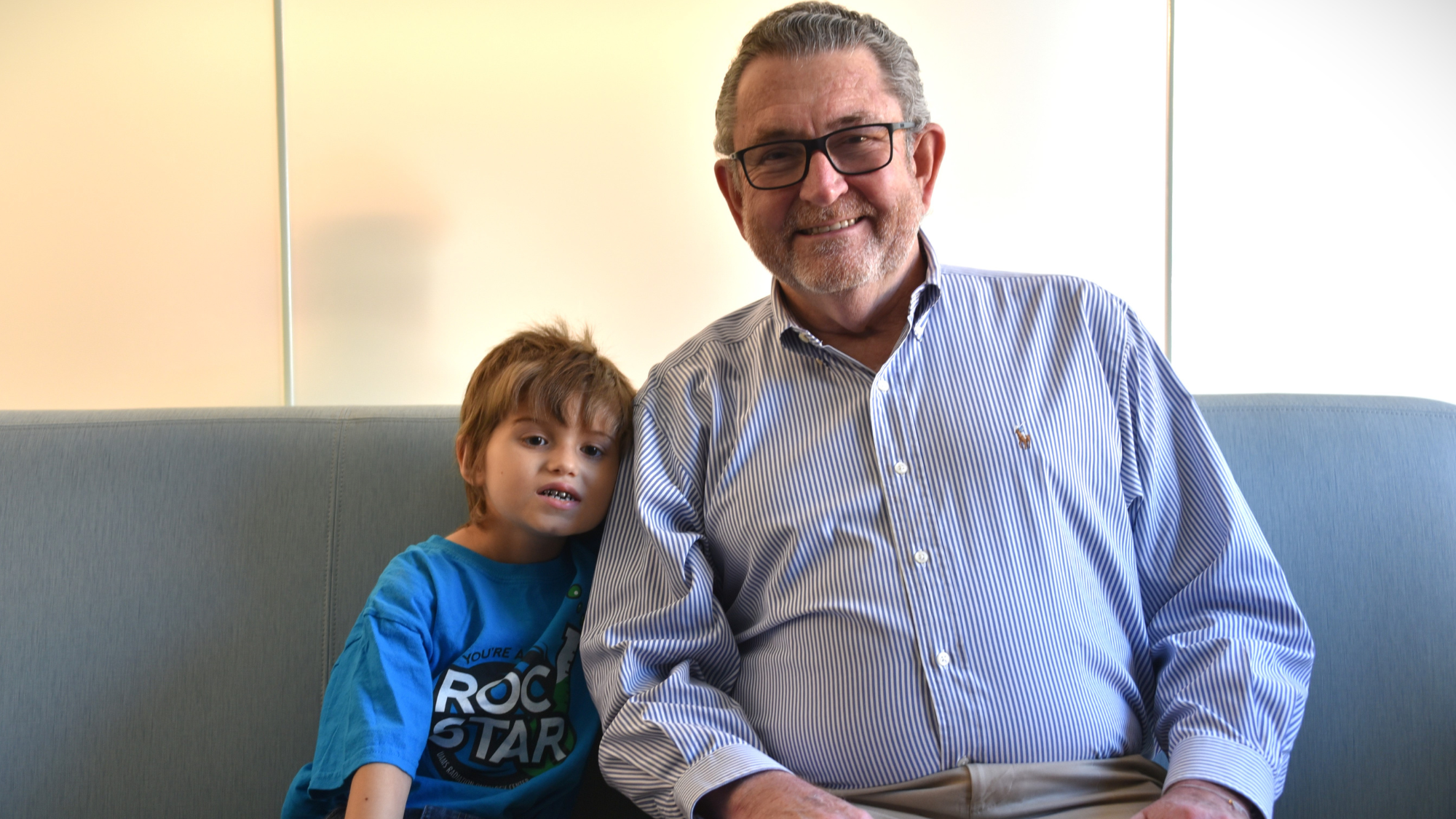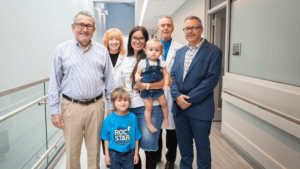View Larger Image

PROTON PALS: Carson Placker, 7, and Bob Sanders, 71, are the 100th patients to receive proton therapy in Arkansas to treat life threatening tumors.
Image by Bryan Clifton
Proton Center of Arkansas Marks 100th Patient Milestone
| Arkansas’ first and only proton radiation center has treated 100 patients since opening in September 2023. To commemorate the milestone, Carson Placker, 7, of Mountain Home, and Bob Sanders, 71, of Conway, rang the end of treatment bell together June 14, surrounded by their physicians and family.
Though 64 years apart in age, the two shared a touching moment when they joined hands and rang the end of treatment bell together.
“Carson is such an inspiration,” said Sanders. “I watch him run into the proton treatment room with no fear, and then he comes out singing. He’s definitely been a bright spot in this experience, and the team here is exceptional.”
A collaboration of the University of Arkansas for Medical Sciences (UAMS), Arkansas Children’s, Baptist Health and Proton International, the Proton Center of Arkansas is the first and only proton center in Arkansas and only the 43rd in the United States.
Sanders has an atypical lipomatous tumor or low-grade soft tissue sarcoma. “He has had surgery in the past, but it keeps recurring,” said Richard Crownover, M.D., Ph.D., UAMS radiation oncologist. “We’re giving him proton therapy to reduce the chance of another recurrence.
“Protons allow us to stop the beam abruptly, deep into the tumor and eliminate any exit dose beyond that,” Crownover said. “We are greatly reducing the radiation dose to the femur, which translates into reduced risk of fracture in the future. We’re also reducing the dose to other muscles in the leg, which translates to better function of the leg and less risk of chronic swelling.”
Proton therapy is one of the most advanced cancer radiation treatments in the world that uses positively charged proton particles to kill cancer cells. Proton’s ability to target cancer without damaging nearby healthy tissue, allows it to achieve a precise attack.
Until the Proton Center of Arkansas opened last year, Arkansas patients needing the therapy were forced to travel out of state for extended periods of time.
“Keeping families together during their treatment is an important part of their care, especially for children,” said Leslie Harrell, D.O., UAMS pediatric radiation oncologist who also treats patients at UAMS Baptist Health Radiation Therapy Center.

Carson’s physicians, Leslie Harrell, D.O., and Kevin Bielamowicz, M.D., and Sanders physician, Richard Crownover, M.D., Ph.D., attended a bell ringing ceremony to celebrate the Proton Center of Arkansas’ 100th patient milestone.
Placker’s physicians, Kevin Bielamowicz, M.D., a pediatric hematologist and oncologist and medical director of Arkansas Children’s Brain Tumor Clinic and assistant professor in hematology and oncology at UAMS, and Harrell, were on hand for the 100th patient celebration.
Due to the location of Placker’s craniopharyngioma, a type of noncancerous tumor in the front middle of his brain, surgical treatments alone were not enough.
“Protons hopefully will be more precise to spare his normal surrounding brain structures such as the eyes, hormone centers and brain tissue,” said Bielamowicz.
“Any damage to these areas of Carson’s brain can impair his vision, hearing, balance, coordination, and general growth and development,” said Harrell. “The physics of proton therapy allow us to shape the proton beam to the exact size, shape and depth of his tumor.”
“He’s been a little more active since starting proton therapy,” said Margarita Placker, Carson’s mother.
Carson wants to be a preacher when he grows up.
Among the first 100 patients, 18 are children with brain, blood, soft tissue, eye and craniospinal cancers. The first 100 patients received treatment for the following cancers:
- Breast
- Central nervous system
- Gastrointestinal
- Head and neck
- Lung
- Lymphoma
- Musculoskeletal
- Prostate
- Benign or other
Proton therapy can treat a broad range of solid tumors that are hard to reach with conventional X-ray radiation.